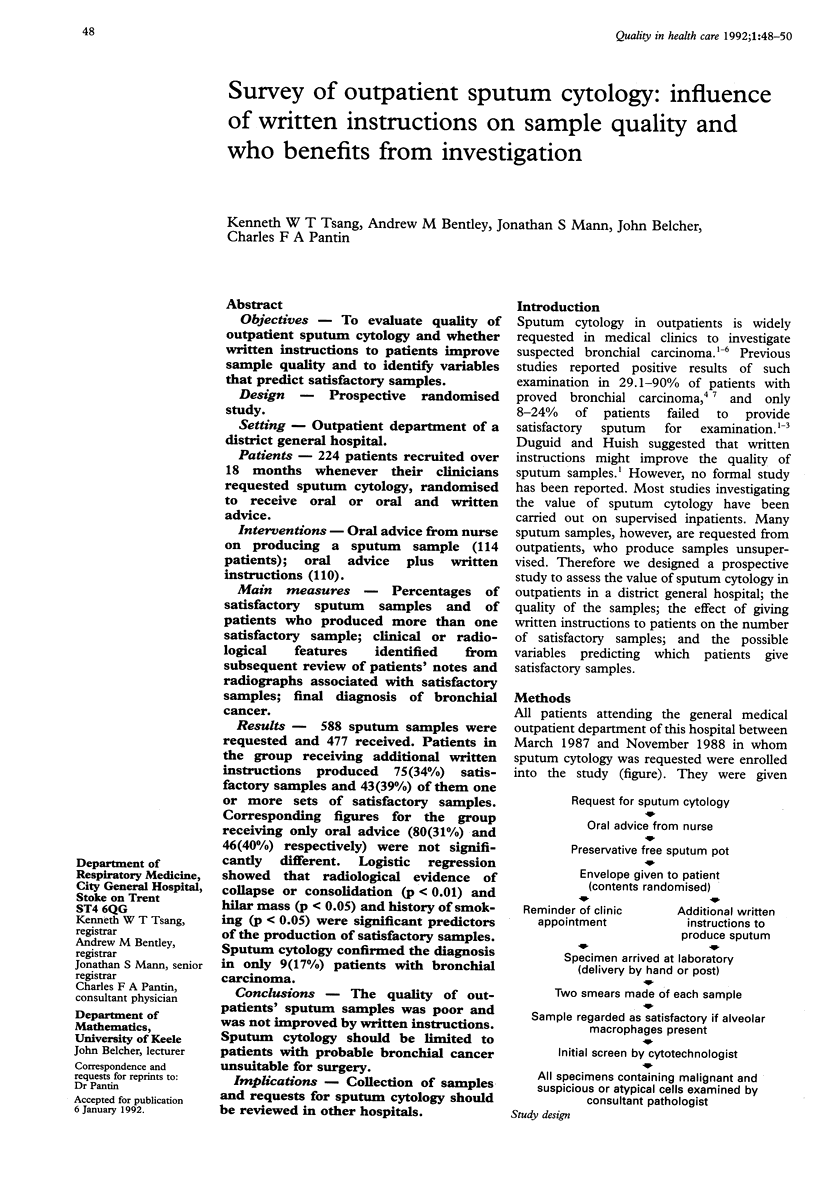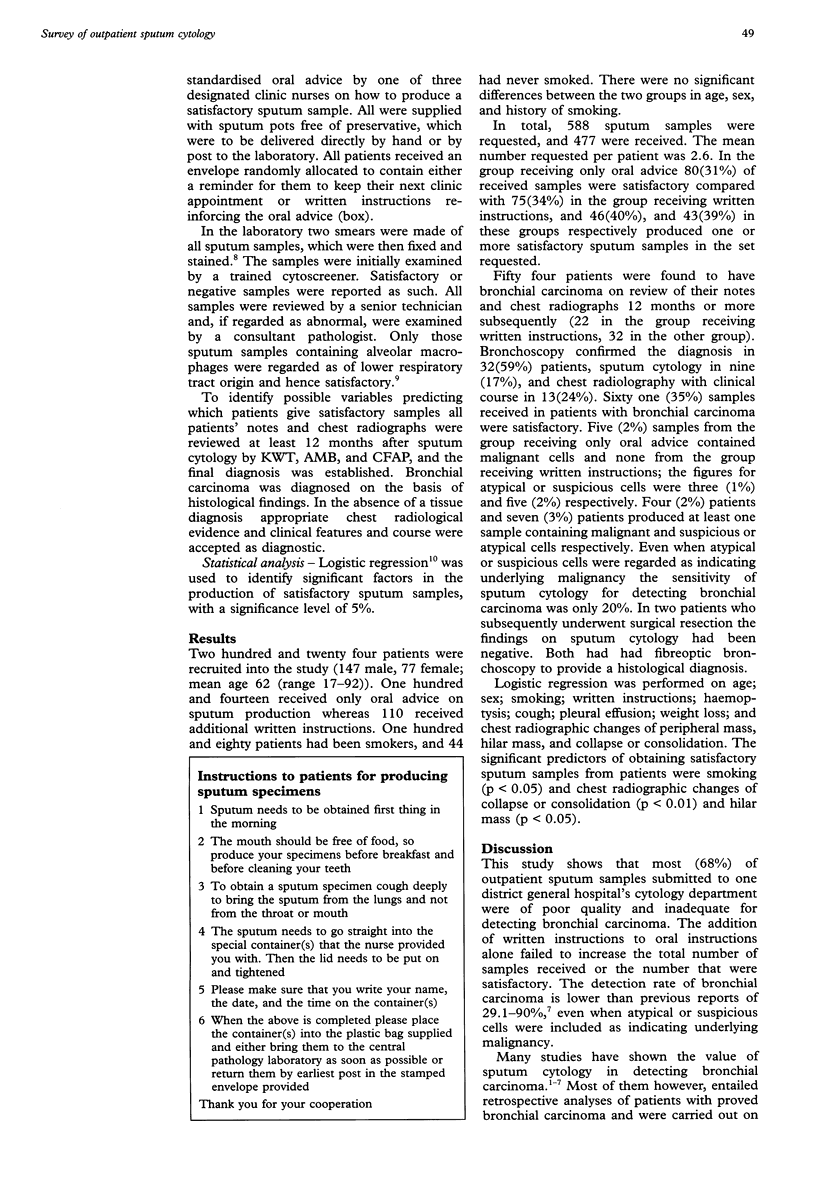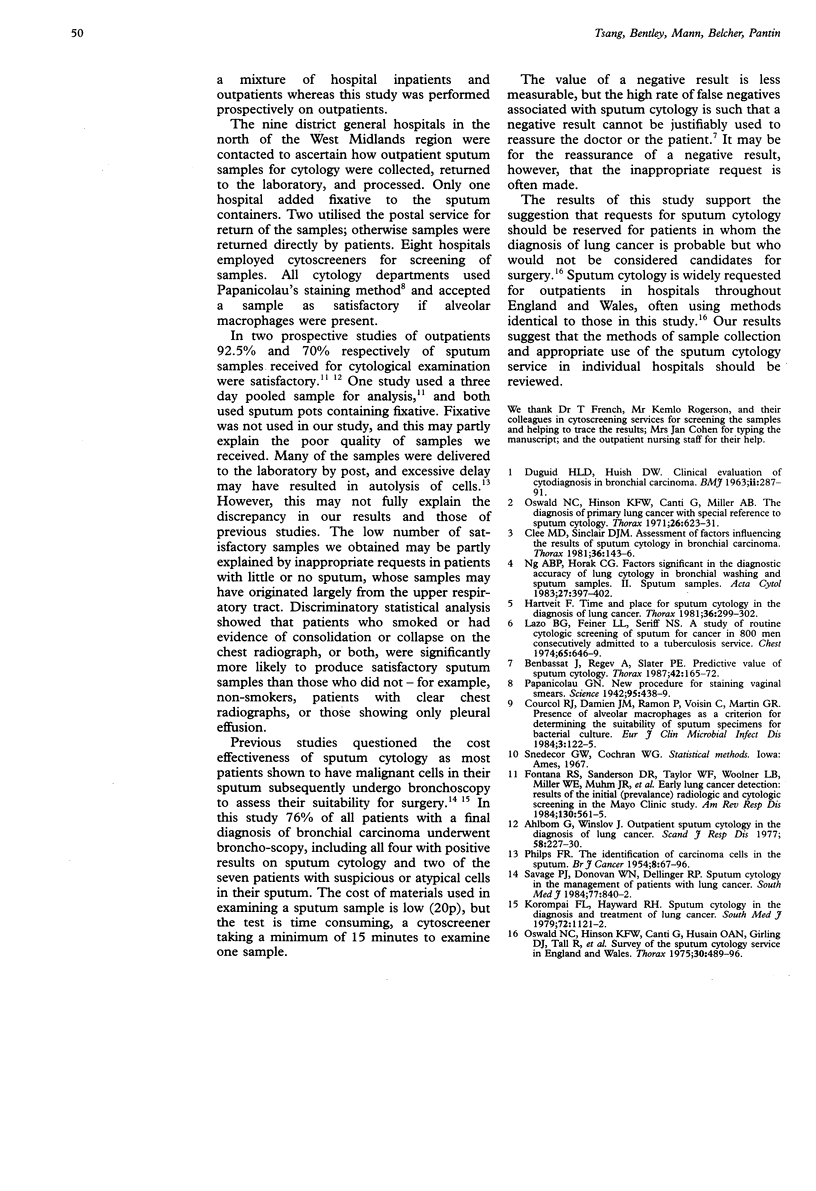Abstract
OBJECTIVES--To evaluated quality of outpatient sputum cytology and whether written instructions to patients improve sample quality and to identify variables that predict satisfactory samples. DESIGN--Prospective randomised study. SETTING--Outpatient department of a district general hospital. PATIENTS--224 patients recruited over 18 months whenever their clinicians requested sputum cytology, randomized to receive oral or oral and written advice. INTERVENTIONS--Oral advice from nurse on producing a sputum sample (114 patients); oral advice plus written instructions (110). MAIN MEASURES--Percentages of satisfactory sputum samples and of patients who produced more than one satisfactory sample; clinical or radiological features identified from subsequent review of patients' notes and radiographs associated with satisfactory samples; final diagnosis of bronchial cancer. RESULTS--588 sputum samples were requested and 477 received. Patients in the group receiving additional written instructions produced 75(34%) satisfactory samples and 43(39%) of them one or more sets of satisfactory samples. Corresponding figures for the group receiving only oral advice (80(31%) and 46(40%) respectively)were not significantly different. Logistic regression showed that radiological evidence of collapse or consolidation (p<0.01) and hilar mass (p<0.05) were significant predictors of the production of satisfactory samples. Sputum cytology confirmed the diagnosis in only 9(17%) patients with bronchial carcinoma. CONCLUSIONS--The quality of outpatients' sputum samples was poor and was not improved by written instructions. Sputum cytology should be limited to patients with probable bronchial cancer unsuitable for surgery. IMPLICATIONS--Collection of samples and requests for sputum cytology should be reviewed in other hospitals.
Full text
PDF


Selected References
These references are in PubMed. This may not be the complete list of references from this article.
- Ahlbom G., Winslov J. Outpatient sputum cytology in the diagnosis of lung cancer. Scand J Respir Dis. 1977 Aug;58(4):227–230. [PubMed] [Google Scholar]
- Benbassat J., Regev A., Slater P. E. Predictive value of sputum cytology. Thorax. 1987 Mar;42(3):165–172. doi: 10.1136/thx.42.3.165. [DOI] [PMC free article] [PubMed] [Google Scholar]
- Clee M. D., Sinclair D. J. Assessment of factors influencing the result of sputum cytology in bronchial carcinoma. Thorax. 1981 Feb;36(2):143–146. doi: 10.1136/thx.36.2.143. [DOI] [PMC free article] [PubMed] [Google Scholar]
- Courcol R. J., Damien J. M., Ramon P., Voisin C., Martin G. R. Presence of alveolar macrophages as a criterion for determining the suitability of sputum specimens for bacterial culture. Eur J Clin Microbiol. 1984 Apr;3(2):122–125. [PubMed] [Google Scholar]
- Duguid H. L., Huish D. W. Clinical Evaluation of Cytodiagnosis in Bronchial Carcinoma. Br Med J. 1963 Aug 3;2(5352):287–291. doi: 10.1136/bmj.2.5352.287. [DOI] [PMC free article] [PubMed] [Google Scholar]
- Fontana R. S., Sanderson D. R., Taylor W. F., Woolner L. B., Miller W. E., Muhm J. R., Uhlenhopp M. A. Early lung cancer detection: results of the initial (prevalence) radiologic and cytologic screening in the Mayo Clinic study. Am Rev Respir Dis. 1984 Oct;130(4):561–565. doi: 10.1164/arrd.1984.130.4.561. [DOI] [PubMed] [Google Scholar]
- Hartveit F. Time and place for sputum cytology in the diagnosis of lung cancer. Thorax. 1981 Apr;36(4):299–302. doi: 10.1136/thx.36.4.299. [DOI] [PMC free article] [PubMed] [Google Scholar]
- Korompal F. L., Hayward R. H. Sputum cytology in the diagnosis and treatment of lung cancer. South Med J. 1979 Sep;72(9):1121–1122. doi: 10.1097/00007611-197909000-00010. [DOI] [PubMed] [Google Scholar]
- Lazo B. G., Feiner L. L., Seriff N. S. A study of routine cytologic screening of sputum for cancer in 800 men consecutively admitted to a tuberculosis service. Chest. 1974 Jun;65(6):646–649. doi: 10.1378/chest.65.6.646. [DOI] [PubMed] [Google Scholar]
- Ng A. B., Horak G. C. Factors significant in the diagnostic accuracy of lung cytology in bronchial washing and sputum samples. II. Sputum samples. Acta Cytol. 1983 Jul-Aug;27(4):397–402. [PubMed] [Google Scholar]
- Oswald N. C., Hinson K. F., Canti G., Husain O. A., Girling D. J., Tall R., Stephens R. J., Fox W. Survey of the sputum cytology service in England and Wales. Thorax. 1975 Oct;30(5):489–496. doi: 10.1136/thx.30.5.489. [DOI] [PMC free article] [PubMed] [Google Scholar]
- Oswald N. C., Hinson K. F., Canti G., Miller A. B. The diagnosis of primary lung cancer with special reference to sputum cytology. Thorax. 1971 Nov;26(6):623–627. doi: 10.1136/thx.26.6.623. [DOI] [PMC free article] [PubMed] [Google Scholar]
- PHILPS F. R. The identification of carcinoma cells in the sputum. Br J Cancer. 1954 Mar;8(1):67–96. doi: 10.1038/bjc.1954.6. [DOI] [PMC free article] [PubMed] [Google Scholar]
- Papanicolaou G. N. A NEW PROCEDURE FOR STAINING VAGINAL SMEARS. Science. 1942 Apr 24;95(2469):438–439. doi: 10.1126/science.95.2469.438. [DOI] [PubMed] [Google Scholar]
- Savage P. J., Donovan W. N., Dellinger R. P. Sputum cytology in the management of patients with lung cancer. South Med J. 1984 Jul;77(7):840–842. doi: 10.1097/00007611-198407000-00013. [DOI] [PubMed] [Google Scholar]


